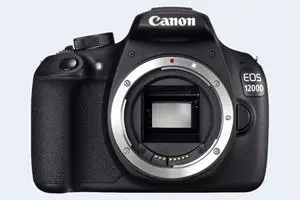Canon 1200D vs Panasonic TZ200
The Canon EOS 1200D (called Canon T5 in some regions) and the Panasonic Lumix DC-TZ200 (labelled Panasonic ZS200 in some countries) are two digital cameras that were announced, respectively, in February 2014 and February 2018. The 1200D is a DSLR, while the TZ200 is a fixed lens compact. The cameras are based on an APS-C (1200D) and an one-inch (TZ200) sensor. The Canon has a resolution of 17.9 megapixels, whereas the Panasonic provides 20 MP.
Below is an overview of the main specs of the two cameras as a starting point for the comparison.

Check 1200D offers at
ebay.com

Check TZ200 price at
amazon.com
Going beyond this snapshot of core features and characteristics, what are the differences between the Canon EOS 1200D and the Panasonic Lumix DC-TZ200? Which one should you buy? Read on to find out how these two cameras compare with respect to their body size, their imaging sensors, their shooting features, their input-output connections, and their reception by expert reviewers.
Body comparison
The physical size and weight of the Canon 1200D and the Panasonic TZ200 are illustrated in the side-by-side display below. The two cameras are presented according to their relative size. Three successive views from the front, the top, and the rear are shown. All width, height and depth measures are rounded to the nearest millimeter.
The TZ200 can be obtained in two different colors (black, silver), while the 1200D is only available in black.
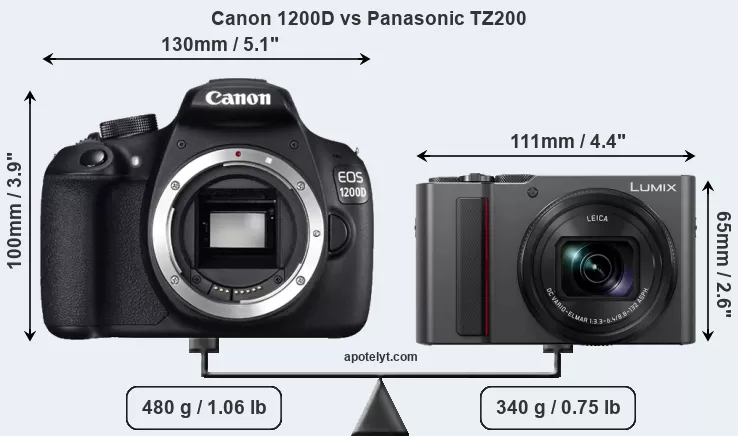
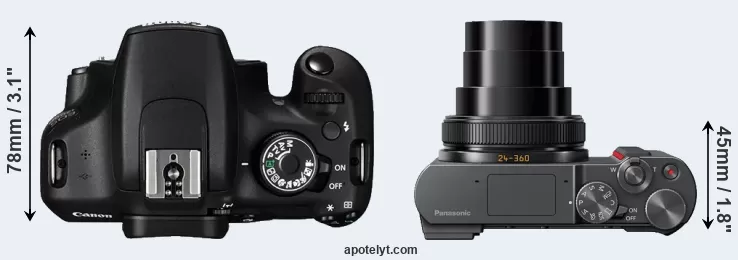
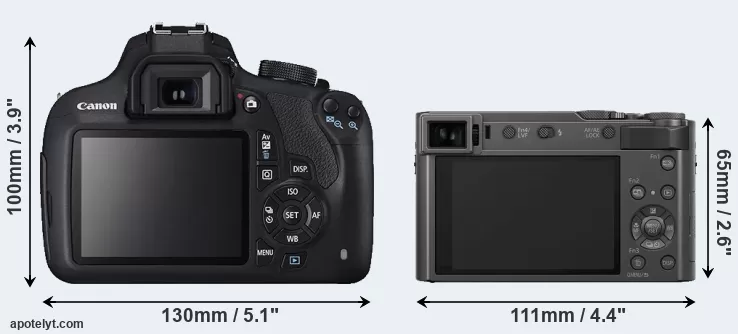
If the front view area (width x height) of the cameras is taken as an aggregate measure of their size, the Panasonic TZ200 is considerably smaller (44 percent) than the Canon 1200D. In this context, it is worth noting that neither the 1200D nor the TZ200 are weather-sealed.
The above size and weight comparisons are to some extent incomplete and possibly misleading, as the TZ200 has a lens built in, whereas the 1200D is an interchangeable lens camera that requires a separate lens. Attaching the latter will add extra weight and bulk to the setup. You can compare the optics available for the 1200D and their specifications in the Canon EF Lens Catalog.
Concerning battery life, the 1200D gets 500 shots out of its Canon LP-E10 battery, while the TZ200 can take 370 images on a single charge of its Panasonic DMW-BLG10 power pack. The power pack in the TZ200 can be charged via the USB port, which can be very convenient when travelling.
The following table provides a synthesis of the main physical specifications of the two cameras and other similar ones. If you want to switch the focus of the display and review another camera pair, you can move across to the CAM-parator tool and choose from the broad selection of possible camera comparisons there.

| Camera Model |
Camera Width |
Camera Height |
Camera Depth |
Camera Weight |
Battery Life |
Weather Sealing |
Camera Launch |
Launch Price (USD) |
Street Price |
||
|---|---|---|---|---|---|---|---|---|---|---|---|
| 1. | Canon 1200D | 130 mm | 100 mm | 78 mm | 480 g | 500 | n | Feb 2014 | 449 | ebay.com | |
| 2. | Panasonic TZ200 | 111 mm | 65 mm | 45 mm | 340 g | 370 | n | Feb 2018 | 799 | amazon.com | |
| 3. | Canon 100D | 117 mm | 91 mm | 69 mm | 407 g | 380 | n | Mar 2013 | 549 | ebay.com | |
| 4. | Canon 650D | 133 mm | 100 mm | 79 mm | 575 g | 440 | n | Jun 2012 | 849 | ebay.com | |
| 5. | Canon 700D | 133 mm | 100 mm | 79 mm | 580 g | 440 | n | Mar 2013 | 649 | ebay.com | |
| 6. | Canon 750D | 132 mm | 101 mm | 78 mm | 555 g | 440 | n | Feb 2015 | 749 | ebay.com | |
| 7. | Canon 760D | 132 mm | 101 mm | 78 mm | 565 g | 440 | n | Feb 2015 | 649 | ebay.com | |
| 8. | Canon 1100D | 130 mm | 100 mm | 78 mm | 495 g | 700 | n | Feb 2011 | 449 | ebay.com | |
| 9. | Canon 1300D | 129 mm | 101 mm | 78 mm | 485 g | 500 | n | Mar 2016 | 449 | ebay.com | |
| 10. | Canon 4000D | 129 mm | 102 mm | 77 mm | 436 g | 500 | n | Feb 2018 | 399 | amazon.com | |
| 11. | Canon G9 X | 98 mm | 58 mm | 31 mm | 209 g | 220 | n | Oct 2015 | 529 | ebay.com | |
| 12. | Canon M10 | 108 mm | 67 mm | 35 mm | 301 g | 255 | n | Oct 2015 | 499 | ebay.com | |
| 13. | Panasonic FZ1000 | 137 mm | 99 mm | 131 mm | 831 g | 360 | n | Jun 2014 | 899 | ebay.com | |
| 14. | Panasonic GX9 | 124 mm | 72 mm | 47 mm | 407 g | 260 | n | Feb 2018 | 849 | ebay.com | |
| 15. | Panasonic LX15 | 106 mm | 60 mm | 42 mm | 310 g | 260 | n | Sep 2016 | 699 | amazon.com | |
| 16. | Panasonic TZ90 | 112 mm | 67 mm | 41 mm | 322 g | 380 | n | Apr 2017 | 449 | ebay.com | |
| 17. | Panasonic TZ100 | 111 mm | 65 mm | 44 mm | 312 g | 300 | n | Jan 2016 | 699 | ebay.com | |
| Note: Measurements and pricing do not include easily detachable parts, such as add-on or interchangeable lenses or optional viewfinders. | |||||||||||
Any camera decision will naturally be influenced heavily by the price. The manufacturer’s suggested retail prices give an idea on the placement of the camera in the maker’s lineup and the broader market. Usually, retail prices stay at first close to the launch price, but after several months, discounts become available. Later in the product cycle and, in particular, when the replacement model is about to appear, further discounting and stock clearance sales often push the camera price considerably down.
Sensor comparison
The size of the imaging sensor is a crucial determinant of image quality. All other things equal, a large sensor will have larger individual pixel-units that offer better low-light sensitivity, wider dynamic range, and richer color-depth than smaller pixels in a sensor of the same technological generation. Moreover, a large sensor camera will give the photographer more control over depth-of-field in the image and, thus, the ability to better isolate a subject from the background. On the downside, larger sensors tend to be associated with larger, more expensive camera bodies and lenses.
Of the two cameras under consideration, the Canon 1200D features an APS-C sensor and the Panasonic TZ200 an one-inch sensor. The sensor area in the TZ200 is 65 percent smaller. As a result of these sensor size differences, the cameras have a format factor of, respectively, 1.6 and 2.7. Both cameras have a native aspect ratio (sensor width to sensor height) of 3:2.
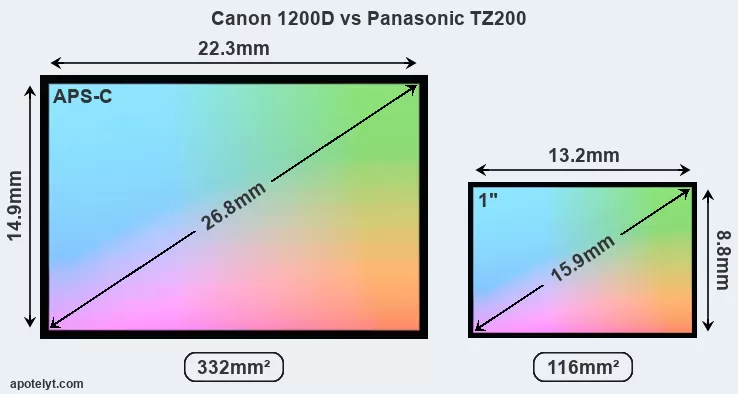
Despite having a smaller sensor, the TZ200 offers a higher resolution of 20 megapixels, compared with 17.9 MP of the 1200D. This megapixels advantage comes at the cost of a higher pixel density and a smaller size of the individual pixel (with a pixel pitch of 2.41μm versus 4.31μm for the 1200D). However, it should be noted that the TZ200 is much more recent (by 4 years) than the 1200D, and its sensor will have benefitted from technological advances during this time that make it possible to gather light more efficiently.
The resolution advantage of the Panasonic TZ200 implies greater flexibility for cropping images or the possibility to print larger pictures. The maximum print size of the TZ200 for good quality output (200 dots per inch) amounts to 27.4 x 18.2 inches or 69.5 x 46.3 cm, for very good quality (250 dpi) 21.9 x 14.6 inches or 55.6 x 37.1 cm, and for excellent quality (300 dpi) 18.2 x 12.2 inches or 46.3 x 30.9 cm. The corresponding values for the Canon 1200D are 25.9 x 17.3 inches or 65.8 x 43.9 cm for good quality, 20.7 x 13.8 inches or 52.7 x 35.1 cm for very good quality, and 17.3 x 11.5 inches or 43.9 x 29.3 cm for excellent quality prints.
The Canon EOS 1200D has a native sensitivity range from ISO 100 to ISO 6400, which can be extended to ISO 100-12800. The corresponding ISO settings for the Panasonic Lumix DC-TZ200 are ISO 125 to ISO 12800, with the possibility to increase the ISO range to 80-25600.
Technology-wise, both cameras are equipped with CMOS (Complementary Metal–Oxide–Semiconductor) sensors. Both cameras use a Bayer filter for capturing RGB colors on a square grid of photosensors. This arrangement is found in most digital cameras.
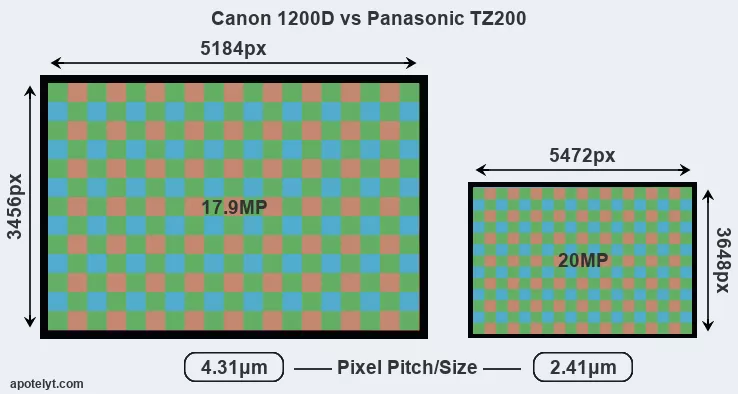
Consistent information on actual sensor performance is available from DXO Mark for many cameras. This service is based on lab testing and assigns an overall score to each camera sensor, as well as ratings for dynamic range ("DXO Landscape"), color depth ("DXO Portrait"), and low-light sensitivity ("DXO Sports"). The following table provides an overview of the physical sensor characteristics, as well as the sensor quality measurements for a selection of comparators.

| Camera Model |
Sensor Class |
Resolution (MP) |
Horiz. Pixels |
Vert. Pixels |
Video Format |
DXO Portrait |
DXO Landscape |
DXO Sports |
DXO Overall |
||
|---|---|---|---|---|---|---|---|---|---|---|---|
| 1. | Canon 1200D | APS-C | 17.9 | 5184 | 3456 | 1080/30p | 21.9 | 11.3 | 724 | 63 | |
| 2. | Panasonic TZ200 | 1-inch | 20.0 | 5472 | 3648 | 4K/30p | 22.0 | 12.2 | 449 | 64 | |
| 3. | Canon 100D | APS-C | 17.9 | 5184 | 3456 | 1080/30p | 21.8 | 11.3 | 843 | 63 | |
| 4. | Canon 650D | APS-C | 17.9 | 5184 | 3456 | 1080/30p | 21.7 | 11.2 | 722 | 62 | |
| 5. | Canon 700D | APS-C | 17.9 | 5184 | 3456 | 1080/30p | 21.7 | 11.2 | 681 | 61 | |
| 6. | Canon 750D | APS-C | 24.0 | 6000 | 4000 | 1080/30p | 22.7 | 12.0 | 919 | 71 | |
| 7. | Canon 760D | APS-C | 24.0 | 6000 | 4000 | 1080/30p | 22.6 | 12.0 | 915 | 70 | |
| 8. | Canon 1100D | APS-C | 12.2 | 4272 | 2848 | 720/30p | 21.9 | 11.0 | 755 | 62 | |
| 9. | Canon 1300D | APS-C | 17.9 | 5184 | 3456 | 1080/30p | 22.0 | 11.7 | 781 | 66 | |
| 10. | Canon 4000D | APS-C | 17.9 | 5184 | 3456 | 1080/30p | 21.9 | 11.4 | 695 | 63 | |
| 11. | Canon G9 X | 1-inch | 20.0 | 5472 | 3648 | 1080/60p | 21.5 | 12.3 | 495 | 63 | |
| 12. | Canon M10 | APS-C | 17.9 | 5184 | 3456 | 1080/30p | 22.2 | 11.4 | 753 | 65 | |
| 13. | Panasonic FZ1000 | 1-inch | 20.0 | 5472 | 3648 | 4K/30p | 22.1 | 11.7 | 517 | 64 | |
| 14. | Panasonic GX9 | Four Thirds | 20.2 | 5184 | 3888 | 4K/30p | 23.1 | 12.8 | 1163 | 74 | |
| 15. | Panasonic LX15 | 1-inch | 20.0 | 5472 | 3648 | 4K/30p | 21.9 | 12.0 | 315 | 62 | |
| 16. | Panasonic TZ90 | 1/2.3 | 20.2 | 5184 | 3888 | 4K/30p | 19.1 | 10.6 | 106 | 36 | |
| 17. | Panasonic TZ100 | 1-inch | 20.0 | 5472 | 3648 | 4K/30p | 22.8 | 12.5 | 559 | 70 | |
| Note: DXO values in italics represent estimates based on sensor size and age. | |||||||||||
Many modern cameras are not only capable of taking still images, but can also record movies. The two cameras under consideration both have sensors whose read-out speed is fast enough to capture moving pictures, but the TZ200 provides a better video resolution than the 1200D. It can shoot movie footage at 4K/30p, while the Canon is limited to 1080/30p.
Feature comparison
Apart from body and sensor, cameras can and do differ across a variety of features. For example, the TZ200 has an electronic viewfinder (2330k dots), while the 1200D has an optical one. Both systems have their advantages, with the electronic viewfinder making it possible to project supplementary shooting information into the framing view, whereas the optical viewfinder offers lag-free viewing and a very clear framing image. The viewfinder in the TZ200 offers a wider field of view (100%) than the one in the 1200D (95%), so that a larger proportion of the captured image is visible in the finder. In addition, the viewfinder of the TZ200 has a higher magnification (0.53x vs 0.50x), so that the size of the image transmitted appears closer to the size seen with the naked human eye. The following table reports on some other key feature differences and similarities of the Canon 1200D, the Panasonic TZ200, and comparable cameras.

| Camera Model |
Viewfinder (Type or 000 dots) |
Control Panel (yes/no) |
LCD Specifications (inch/000 dots) |
LCD Attach- ment |
Touch Screen (yes/no) |
Max Shutter Speed * |
Max Shutter Flaps * |
Built-in Flash (yes/no) |
Built-in Image Stab |
||
|---|---|---|---|---|---|---|---|---|---|---|---|
| 1. | Canon 1200D | optical | n | 3.0 / 460 | fixed | n | 1/4000s | 3.0/s | Y | n | |
| 2. | Panasonic TZ200 | 2330 | n | 3.0 / 1240 | fixed | Y | 1/2000s | 10.0/s | Y | Y | |
| 3. | Canon 100D | optical | n | 3.0 / 1040 | fixed | Y | 1/4000s | 4.9/s | Y | n | |
| 4. | Canon 650D | optical | n | 3.0 / 1040 | swivel | Y | 1/4000s | 5.0/s | Y | n | |
| 5. | Canon 700D | optical | n | 3.0 / 1040 | swivel | Y | 1/4000s | 5.0/s | Y | n | |
| 6. | Canon 750D | optical | n | 3.0 / 1040 | swivel | Y | 1/4000s | 5.0/s | Y | n | |
| 7. | Canon 760D | optical | Y | 3.0 / 1040 | swivel | Y | 1/4000s | 5.0/s | Y | n | |
| 8. | Canon 1100D | optical | n | 2.7 / 230 | fixed | n | 1/4000s | 3.0/s | Y | n | |
| 9. | Canon 1300D | optical | n | 3.0 / 920 | fixed | n | 1/4000s | 3.0/s | Y | n | |
| 10. | Canon 4000D | optical | n | 2.7 / 230 | fixed | n | 1/4000s | 3.0/s | Y | n | |
| 11. | Canon G9 X | none | n | 3.0 / 1040 | fixed | Y | 1/2000s | 6.0/s | Y | Y | |
| 12. | Canon M10 | none | n | 3.0 / 1040 | tilting | Y | 1/4000s | 4.6/s | Y | n | |
| 13. | Panasonic FZ1000 | 2359 | n | 3.0 / 921 | swivel | n | 1/4000s | 12.0/s | Y | Y | |
| 14. | Panasonic GX9 | 2760 | n | 3.0 / 1240 | tilting | Y | 1/4000s | 9.0/s | Y | Y | |
| 15. | Panasonic LX15 | none | n | 3.0 / 1040 | tilting | Y | 1/4000s | 10.0/s | Y | Y | |
| 16. | Panasonic TZ90 | 1166 | n | 3.0 / 1040 | tilting | Y | 1/2000s | 10.0/s | Y | Y | |
| 17. | Panasonic TZ100 | 1166 | n | 3.0 / 1040 | fixed | Y | 1/2000s | 10.0/s | Y | Y | |
| Note: *) Information refers to the mechanical shutter, unless the camera only has an electronic one. | |||||||||||
One differentiating feature between the two cameras concerns the touch sensitivity of the rear screen. The TZ200 has a touchscreen, while the 1200D has a conventional panel. Touch control can be particularly helpful, for example, for setting the focus point.
The reported shutter speed information refers to the use of the mechanical shutter. Yet, some cameras only have an electronic shutter, while others have an electronic shutter in addition to a mechanical one. In fact, the TZ200 is one of those camera that have an additional electronic shutter, which makes completely silent shooting possible. However, this mode is less suitable for photographing moving objects (risk of rolling shutter) or shooting under artificial light sources (risk of flickering).
The Panasonic TZ200 has an intervalometer built-in. This enables the photographer to capture time lapse sequences, such as flower blooming, a sunset or moon rise, without purchasing an external camera trigger and related software.
Concerning the storage of imaging data, both the 1200D and the TZ200 write their files to SDXC cards. The TZ200 supports UHS-I cards (Ultra High Speed data transfer of up to 104 MB/s), while the 1200D cannot take advantage of Ultra High Speed SD cards.
Connectivity comparison
For some imaging applications, the extent to which a camera can communicate with its environment can be an important aspect in the camera decision process. The table below provides an overview of the connectivity of the Canon EOS 1200D and Panasonic Lumix DC-TZ200 and, in particular, the interfaces the cameras (and selected comparators) provide for accessory control and data transfer.

| Camera Model |
Hotshoe Port |
Internal Mic / Speaker |
Microphone Port |
Headphone Port |
HDMI Port |
USB Port |
WiFi Support |
NFC Support |
Bluetooth Support |
||
|---|---|---|---|---|---|---|---|---|---|---|---|
| 1. | Canon 1200D | Y | mono / mono | - | - | mini | 2.0 | - | - | - | |
| 2. | Panasonic TZ200 | - | stereo / mono | - | - | micro | 2.0 | Y | - | Y | |
| 3. | Canon 100D | Y | mono / mono | Y | - | mini | 2.0 | - | - | - | |
| 4. | Canon 650D | Y | stereo / mono | Y | - | mini | 2.0 | - | - | - | |
| 5. | Canon 700D | Y | stereo / mono | Y | - | mini | 2.0 | - | - | - | |
| 6. | Canon 750D | Y | stereo / mono | Y | - | mini | 2.0 | Y | Y | - | |
| 7. | Canon 760D | Y | stereo / mono | Y | - | mini | 2.0 | Y | Y | - | |
| 8. | Canon 1100D | Y | stereo / mono | - | - | mini | 2.0 | - | - | - | |
| 9. | Canon 1300D | Y | mono / mono | - | - | mini | 2.0 | Y | Y | - | |
| 10. | Canon 4000D | Y | mono / mono | - | - | mini | 2.0 | Y | Y | - | |
| 11. | Canon G9 X | - | stereo / mono | - | - | micro | 2.0 | Y | Y | - | |
| 12. | Canon M10 | - | stereo / mono | - | - | mini | 2.0 | Y | Y | - | |
| 13. | Panasonic FZ1000 | Y | stereo / mono | Y | - | micro | 2.0 | Y | Y | - | |
| 14. | Panasonic GX9 | Y | stereo / mono | - | - | micro | 2.0 | Y | - | Y | |
| 15. | Panasonic LX15 | - | stereo / mono | - | - | micro | 2.0 | Y | - | - | |
| 16. | Panasonic TZ90 | - | stereo / mono | - | - | micro | 2.0 | Y | - | - | |
| 17. | Panasonic TZ100 | - | stereo / mono | - | - | micro | 2.0 | Y | - | - |
It is notable that the 1200D has a hotshoe, while the TZ200 does not. This socket makes it possible to easily attach optional accessories, such as an external flash gun.
The TZ200 is a recent model that features in the current product line-up of Panasonic. In contrast, the 1200D has been discontinued (but can be found pre-owned on ebay). As a replacement in the same line of cameras, the 1200D was succeeded by the Canon 1300D. Further information on the features and operation of the 1200D and TZ200 can be found, respectively, in the Canon 1200D Manual (free pdf) or the online Panasonic TZ200 Manual.
Review summary
So what conclusions can be drawn? Is there a clear favorite between the Canon 1200D and the Panasonic TZ200? Which camera is better? The listing below highlights the relative strengths of the two models.

Reasons to prefer the Canon EOS 1200D:
- Brighter framing: Features an optical viewfinder for clear, lag-free composition.
- Faster shutter: Has higher mechanical shutter speed (1/4000s vs 1/2000s) to freeze action.
- More flexible: Can take a variety of interchangeable lenses, including specialty optics.
- Longer lasting: Can take more shots (500 versus 370) on a single battery charge.
- Better lighting: Features a hotshoe and can thus hold and trigger an external flash gun.
- More heavily discounted: Has been available for much longer (launched in February 2014).

Arguments in favor of the Panasonic Lumix DC-TZ200:
- More detail: Has more megapixels (20 vs 17.9MP), which boosts linear resolution by 6%.
- Better video: Provides higher definition movie capture (4K/30p vs 1080/30p).
- More framing info: Has an electronic viewfinder that displays shooting data.
- More complete view: Has a viewfinder with a larger field of view (100% vs 95%).
- Larger viewfinder image: Features a viewfinder with a higher magnification (0.53x vs 0.50x).
- More detailed LCD: Has a higher resolution rear screen (1240k vs 460k dots).
- Fewer buttons to press: Has a touchscreen to facilitate handling and shooting adjustments.
- Faster burst: Shoots at higher frequency (10 vs 3 flaps/sec) to capture the decisive moment.
- Less disturbing: Has an electronic shutter option for completely silent shooting.
- Easier time-lapse photography: Has an intervalometer built-in for low frequency shooting.
- Ready to shoot: Comes with an integrated lens, while the 1200D requires a separate lens.
- More compact: Is smaller (111x65mm vs 130x100mm) and will fit more readily into a bag.
- Less heavy: Has a lower weight even though it has a lens built in (unlike the 1200D).
- Easier travel charging: Can be conveniently charged via its USB port.
- Sharper images: Has stabilization technology built-in to reduce the impact of hand-shake.
- Easier file upload: Has wifi built in for automatic backup or image transfer to the web.
- Easier wireless transfer: Supports Bluetooth for image sharing without cables.
- Faster buffer clearing: Has an SD card interface that supports the UHS-I standard.
- More modern: Reflects 4 years of technical progress since the 1200D launch.
If the count of individual advantages (bullet points above) is taken as a guide, the TZ200 is the clear winner of the contest (19 : 6 points). However, the relevance of individual strengths will vary across photographers, so that you might want to apply your own weighing scheme to the summary points when reflecting and deciding on a new camera. A professional wildlife photographer will view the differences between cameras in a way that diverges from the perspective of a family photog, and a person interested in architecture has distinct needs from a sports shooter. Hence, the decision which camera is best and worth buying is often a very personal one.
How about other alternatives? Do the specifications of the Canon 1200D and the Panasonic TZ200 place the cameras among the top in their class? Find out in the latest Best DSLR Camera and Best Superzoom Camera listings whether the two cameras rank among the cream of the crop.
In any case, while the comparison of the spec-sheets of cameras can offer a general idea of their imaging potential, it remains partial and cannot reveal, for example, the shooting experience and imaging performance when actually working with the 1200D or the TZ200. User reviews, such as those found at amazon, can sometimes inform about these issues, but such feedback is often incomplete, inconsistent, and biased.
Expert reviews
This is why hands-on reviews by experts are important. The table below provides a synthesis of the camera assessments of some of the best known photo-gear review sites (amateurphotographer [AP], cameralabs [CL], digitalcameraworld [DCW], dpreview [DPR], ephotozine [EPZ], photographyblog [PB]). As can be seen, the professional reviewers agree in many cases on the quality of different cameras, but sometimes their assessments diverge, reinforcing the earlier point that a camera decision is often a very personal choice.

| Camera Model |
AP score |
CL score |
DCW score |
DPR score |
EPZ score |
PB score |
Camera Launch |
Launch Price (USD) |
Street Price |
||
|---|---|---|---|---|---|---|---|---|---|---|---|
| 1. | Canon 1200D | 3/5 | + | .. | .. | 4/5 | 4.5/5 | Feb 2014 | 449 | ebay.com | |
| 2. | Panasonic TZ200 | .. | + + | 4.5/5 | 81/100 | 4.5/5 | 4.5/5 | Feb 2018 | 799 | amazon.com | |
| 3. | Canon 100D | 4/5 | + | .. | 78/100 | 4/5 | 4/5 | Mar 2013 | 549 | ebay.com | |
| 4. | Canon 650D | 4/5 | + + | .. | 77/100 | 4.5/5 | 4.5/5 | Jun 2012 | 849 | ebay.com | |
| 5. | Canon 700D | .. | .. | .. | 76/100 | 4.5/5 | 4.5/5 | Mar 2013 | 649 | ebay.com | |
| 6. | Canon 750D | 5/5 | .. | .. | 75/100 | 4.5/5 | 4.5/5 | Feb 2015 | 749 | ebay.com | |
| 7. | Canon 760D | 5/5 | + | .. | 77/100 | 4.5/5 | 4.5/5 | Feb 2015 | 649 | ebay.com | |
| 8. | Canon 1100D | .. | 80/100 | .. | 69/100 | 4/5 | 4.5/5 | Feb 2011 | 449 | ebay.com | |
| 9. | Canon 1300D | 4/5 | o | 4/5 | 73/100 | 4/5 | 4/5 | Mar 2016 | 449 | ebay.com | |
| 10. | Canon 4000D | 2.5/5 | o | 3/5 | .. | 3.5/5 | 3.5/5 | Feb 2018 | 399 | amazon.com | |
| 11. | Canon G9 X | 3.5/5 | + + | .. | .. | 4.5/5 | 4.5/5 | Oct 2015 | 529 | ebay.com | |
| 12. | Canon M10 | .. | .. | .. | .. | .. | 4/5 | Oct 2015 | 499 | ebay.com | |
| 13. | Panasonic FZ1000 | 4/5 | + + | .. | 82/100 | 4.5/5 | 4.5/5 | Jun 2014 | 899 | ebay.com | |
| 14. | Panasonic GX9 | 4/5 | + | 4/5 | 84/100 | 4.5/5 | 4.5/5 | Feb 2018 | 849 | ebay.com | |
| 15. | Panasonic LX15 | .. | + + | 4/5 | 81/100 | 4/5 | 4.5/5 | Sep 2016 | 699 | amazon.com | |
| 16. | Panasonic TZ90 | .. | + + | 4/5 | .. | 4/5 | 4/5 | Apr 2017 | 449 | ebay.com | |
| 17. | Panasonic TZ100 | 4.5/5 | + + | .. | 82/100 | 4.5/5 | 4.5/5 | Jan 2016 | 699 | ebay.com | |
| Note: (+ +) highly recommended; (+) recommended; (o) reviewed; (..) not available. | |||||||||||
The above review scores should be interpreted with care, though. The assessments were made in relation to similar cameras of the same technological generation. Thus, a score needs to be put into the context of the launch date and the launch price of the camera, and comparisons of ratings among very different cameras or across long time periods have little meaning. Also, kindly note that some of the listed sites have over time developped their review approaches and their reporting style.

Check 1200D offers at
ebay.com

Check TZ200 price at
amazon.com
Other camera comparisons
Did this review help to inform your camera decision process? In case you would like to check on the differences and similarities of other camera models, just make your choice using the following search menu. There is also a set of direct links to comparison reviews that other users of the CAM-parator app explored.
- Canon 1200D vs Nikon D3500
- Canon 1200D vs Nikon D800E
- Canon 1200D vs Olympus E-M10 II
- Canon 1200D vs Olympus E-PL3
- Canon 1200D vs Panasonic LX5
- Canon 1200D vs Sony HX99
- Leica S-E Typ 006 vs Panasonic TZ200
- Olympus E-M10 III vs Panasonic TZ200
- Olympus TG-5 vs Panasonic TZ200
- Panasonic TZ200 vs Ricoh WG-6
- Panasonic TZ200 vs Samsung NX30
- Panasonic TZ200 vs Sony NEX-3
Specifications: Canon 1200D vs Panasonic TZ200
Below is a side-by-side comparison of the specs of the two cameras to facilitate a quick review of their differences and common features.
| Camera Model | Canon 1200D | Panasonic TZ200 |
|---|---|---|
| Camera Type | Digital single lens reflex | Fixed lens compact camera |
| Camera Lens | Canon EF mount lenses | 24-360mm f/3.3-6.4 |
| Launch Date | February 2014 | February 2018 |
| Launch Price | USD 449 | USD 799 |
| Sensor Specs | Canon 1200D | Panasonic TZ200 |
| Sensor Technology | CMOS | CMOS |
| Sensor Format | APS-C Sensor | 1" Sensor |
| Sensor Size | 22.3 x 14.9 mm | 13.2 x 8.8 mm |
| Sensor Area | 332.27 mm2 | 116.16 mm2 |
| Sensor Diagonal | 26.8 mm | 15.9 mm |
| Crop Factor | 1.6x | 2.7x |
| Sensor Resolution | 17.9 Megapixels | 20 Megapixels |
| Image Resolution | 5184 x 3456 pixels | 5472 x 3648 pixels |
| Pixel Pitch | 4.31 μm | 2.41 μm |
| Pixel Density | 5.39 MP/cm2 | 17.18 MP/cm2 |
| Moiré control | Anti-Alias filter | Anti-Alias filter |
| Movie Capability | 1080/30p Video | 4K/30p Video |
| ISO Setting | 100 - 6,400 ISO | 125 - 12,800 ISO |
| ISO Boost | 100 - 12,800 ISO | 80 - 25,600 ISO |
| Image Processor | DIGIC 4 | Venus |
| DXO Sensor Quality (score) | 63 | .. |
| DXO Color Depth (bits) | 21.9 | .. |
| DXO Dynamic Range (EV) | 11.3 | .. |
| DXO Low Light (ISO) | 724 | .. |
| Screen Specs | Canon 1200D | Panasonic TZ200 |
| Viewfinder Type | Optical viewfinder | Electronic viewfinder |
| Viewfinder Field of View | 95% | 100% |
| Viewfinder Magnification | 0.50x | 0.53x |
| Viewfinder Resolution | 2330k dots | |
| LCD Framing | Live View | Live View |
| Rear LCD Size | 3.0inch | 3.0inch |
| LCD Resolution | 460k dots | 1240k dots |
| LCD Attachment | Fixed screen | Fixed screen |
| Touch Input | no Touchscreen | Touchscreen |
| Shooting Specs | Canon 1200D | Panasonic TZ200 |
| Focus System | Phase-detect AF | Contrast-detect AF |
| Manual Focusing Aid | no Peaking Feature | Focus Peaking |
| Max Shutter Speed (mechanical) | 1/4000s | 1/2000s |
| Continuous Shooting | 3 shutter flaps/s | 10 shutter flaps/s |
| Electronic Shutter | no E-Shutter | up to 1/16000s |
| Time-Lapse Photography | no Intervalometer | Intervalometer built-in |
| Image Stabilization | Lens stabilization only | In-body stabilization |
| Fill Flash | Built-in Flash | Built-in Flash |
| Storage Medium | SDXC cards | SDXC cards |
| Single or Dual Card Slots | Single card slot | Single card slot |
| UHS card support | no | UHS-I |
| Connectivity Specs | Canon 1200D | Panasonic TZ200 |
| External Flash | Hotshoe | no Hotshoe |
| USB Connector | USB 2.0 | USB 2.0 |
| HDMI Port | mini HDMI | micro HDMI |
| Wifi Support | no Wifi | Wifi built-in |
| Bluetooth Support | no Bluetooth | Bluetooth built-in |
| Body Specs | Canon 1200D | Panasonic TZ200 |
| Battery Type | Canon LP-E10 | Panasonic DMW-BLG10 |
| Battery Life (CIPA) | 500 shots per charge | 370 shots per charge |
| In-Camera Charging | no USB charging | USB charging |
| Body Dimensions |
130 x 100 x 78 mm (5.1 x 3.9 x 3.1 in) |
111 x 65 x 45 mm (4.4 x 2.6 x 1.8 in) |
| Camera Weight | 480 g (16.9 oz) | 340 g (12.0 oz) |

Check 1200D offers at
ebay.com

Check TZ200 price at
amazon.com
Did you notice an error on this page? If so, please get in touch, so that we can correct the information.
